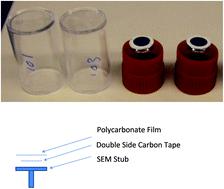当前位置:
X-MOL 学术
›
Environ. Sci.: Processes Impacts
›
论文详情
Our official English website, www.x-mol.net, welcomes your
feedback! (Note: you will need to create a separate account there.)
Using low cost open-face passive samplers to sample PM concentration and elemental composition in childcare facilities.
Environmental Science: Processes & Impacts ( IF 4.3 ) Pub Date : 2020-06-12 , DOI: 10.1039/d0em00075b Zhong-Min Wang 1 , Yixin Zhou 2 , Fraser W Gaspar 3 , Asa Bradman 3
Environmental Science: Processes & Impacts ( IF 4.3 ) Pub Date : 2020-06-12 , DOI: 10.1039/d0em00075b Zhong-Min Wang 1 , Yixin Zhou 2 , Fraser W Gaspar 3 , Asa Bradman 3
Affiliation

|
Effective, low noise and low-cost samplers for airborne particulate matter (PM) in indoor environments are needed. In 15 northern California childcare facilities, we deployed open-faced polycarbonate substrate passive aerosol samplers and analyzed them using computer-controlled scanning electron microscopy to measure indoor PM particle size, number, and elemental concentration. Particle concentrations were compared to PM concentrations measured by filter-based active samplers. The PM mass concentrations measured after open-faced passive sampling were in good agreement with the PM concentrations obtained using co-located active samplers. The measured PM2.5 concentrations inside of the childcare facilities were in the range of 6–31 μg m−3, while the PM10 concentrations were in the range of 17–96 μg m−3. For PM10, 93.3% of the passive sampler results were within ±30% of those determined with the active sampler, and 67% of the PM2.5 results fell within ±30% of the active sampler measurements. The Pearson's correlation coefficient between PM mass concentrations estimated from the open-faced passive aerosol sampler (OPS) versus gravimetric (active sampler) methods was 0.77 for PM2.5 and 0.95 for PM10, respectively, indicating a strong correlation between the passive and active sampler results. PM and elemental composition varied by facility location and interior characteristics of the childcare facilities such as floor type, presence of combustion sources, occupant density, and the level of activity. The rich carbon content in the polycarbonate substrate produced positive bias in the carbon concentration analysis. Based on the carbon concentration, determined using a copper substrate, a correction factor was needed to determine the total carbon concentrations in the sampled PM for the polycarbonate substrate passive sampler. Overall, the results demonstrated that the OPS collected enough aerosol particles in one business day (6–8 hours) to assess PM levels.
中文翻译:

在育儿设施中使用低成本的无源被动采样器采样PM浓度和元素组成。
需要在室内环境中使用有效,低噪声,低成本的空气中颗粒物(PM)采样器。在北加州的15个儿童保育机构中,我们部署了开放式的聚碳酸酯基质被动气溶胶采样器,并使用计算机控制的扫描电子显微镜对它们进行了分析,以测量室内的PM粒径,数量和元素浓度。将颗粒浓度与通过基于过滤器的有源采样器测量的PM浓度进行比较。敞开式被动采样后测得的PM质量浓度与使用共置主动采样器获得的PM浓度高度吻合。育儿设施内部测得的PM 2.5浓度范围为6–31μgm -3,而PM 10浓度范围为17–96μgm -3。对于PM 10,无源采样器结果的93.3%在有源采样器确定的结果的±30%之内,而PM 2.5的结果中有67%降到有源采样器测量结果的±30%之内。从敞开式被动气溶胶采样器(OPS)与重量法(主动采样器)方法估算的PM质量浓度之间的Pearson相关系数对于PM 2.5为0.77,对于PM 10为0.95分别表示被动和主动采样器结果之间的强相关性。PM和元素组成因托儿所的设施位置和内部特征(例如地板类型,燃烧源的存在,乘员密度和活动水平)而异。聚碳酸酯基材中的富碳含量在碳浓度分析中产生了正偏差。基于使用铜基板确定的碳浓度,需要校正因子来确定聚碳酸酯基板无源采样器的采样PM中的总碳浓度。总体而言,结果表明OPS在一个工作日(6-8小时)内收集了足够的气溶胶颗粒以评估PM水平。
更新日期:2020-07-22
中文翻译:

在育儿设施中使用低成本的无源被动采样器采样PM浓度和元素组成。
需要在室内环境中使用有效,低噪声,低成本的空气中颗粒物(PM)采样器。在北加州的15个儿童保育机构中,我们部署了开放式的聚碳酸酯基质被动气溶胶采样器,并使用计算机控制的扫描电子显微镜对它们进行了分析,以测量室内的PM粒径,数量和元素浓度。将颗粒浓度与通过基于过滤器的有源采样器测量的PM浓度进行比较。敞开式被动采样后测得的PM质量浓度与使用共置主动采样器获得的PM浓度高度吻合。育儿设施内部测得的PM 2.5浓度范围为6–31μgm -3,而PM 10浓度范围为17–96μgm -3。对于PM 10,无源采样器结果的93.3%在有源采样器确定的结果的±30%之内,而PM 2.5的结果中有67%降到有源采样器测量结果的±30%之内。从敞开式被动气溶胶采样器(OPS)与重量法(主动采样器)方法估算的PM质量浓度之间的Pearson相关系数对于PM 2.5为0.77,对于PM 10为0.95分别表示被动和主动采样器结果之间的强相关性。PM和元素组成因托儿所的设施位置和内部特征(例如地板类型,燃烧源的存在,乘员密度和活动水平)而异。聚碳酸酯基材中的富碳含量在碳浓度分析中产生了正偏差。基于使用铜基板确定的碳浓度,需要校正因子来确定聚碳酸酯基板无源采样器的采样PM中的总碳浓度。总体而言,结果表明OPS在一个工作日(6-8小时)内收集了足够的气溶胶颗粒以评估PM水平。











































 京公网安备 11010802027423号
京公网安备 11010802027423号